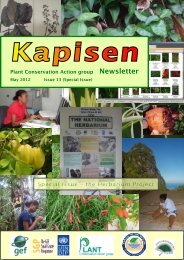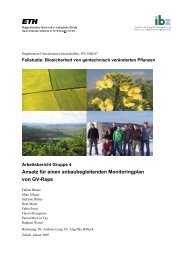Kapisen - ETH Zürich
Kapisen - ETH Zürich
Kapisen - ETH Zürich
You also want an ePaper? Increase the reach of your titles
YUMPU automatically turns print PDFs into web optimized ePapers that Google loves.
R e d D a t a L i s t<br />
Fig. 2 The ‘overview’ table of the database. This table gives some general taxonomic information of a species and<br />
shows a photograph. Each of the red buttons on the right side leads to a specific data table, e.g. on the distribution or<br />
the utilization of the species (M Burger and N Stampfli)<br />
Methodology to survey threatened plant species<br />
in Seychelles<br />
To determine the IUCN Red List Status of a species,<br />
specific data is needed. The question was how to<br />
obtain such data and more particularly which field<br />
methods to use for very rare plant species.<br />
For commoner species (Fig. 1) fast sampling methods<br />
such as trail transects that have been widely<br />
applied in Seychelles are suitable. For many areas<br />
on Mahé and Praslin such data exists (see e.g. <strong>Kapisen</strong><br />
1(1), p. 8). These datasets need to be standardized,<br />
compiled and completed.<br />
For very rare species, sampling data is of limited<br />
use because it will never be possible to completely<br />
sample the natural areas of the Seychelles. For<br />
these species we therefore propose to locate individuals<br />
known from the literature or expert knowledge<br />
with GPS (Fig. 3). Based on knowledge about the<br />
biology or the known locations of a species, further<br />
individuals can be sought. A problem is that a dense<br />
canopy cover and/or cloudy weather can make GPS<br />
reception impossible. In such cases the position of<br />
the plant has to be estimated with the help of a compass<br />
and a measuring tape relative to the nearest<br />
known GPS position.<br />
Database<br />
A database was designed in FileMakerPro (Version<br />
7) (Fig. 2). This database allows the storage and organization<br />
of information and data about the taxonomy,<br />
description, biology, distribution of and threats to<br />
Seychelles’ plants, including photographs and GIS<br />
maps. The database calculates a preliminary assessment<br />
of the conservation status of each species<br />
according to the IUCN guidelines. For a final assessment<br />
the necessary data can easily be transferred<br />
to the entry form of the database hosted by IUCN.<br />
Besides managing the data necessary for the IUCN<br />
assessment, the database can be used by managers<br />
and scientists who want to retrieve specific information<br />
about a species. Some of the information<br />
may be made accessible to a wider public for awareness<br />
building. More sensitive information, such as<br />
GPS positions of rare species, will be protected by<br />
password.<br />
Expert Workshop<br />
On February 2nd 2004, a workshop was organised<br />
by us (Maria, Nathalie and James) to present the status<br />
of our work (Fig. 4). The workshop saw the participation<br />
of PCA members and various stakeholders<br />
K a p i s e n 1 5 I s s u e 3







